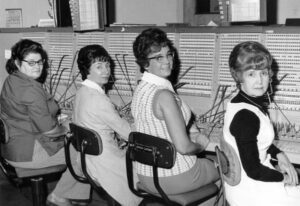If you take a look at our What is VoIP? guide, you’ll read about how the Public Switched Telephone Network (PSTN) comprises a host of analog and digital systems like cellular networks, undersea fiber optic cables, and copper telephone lines that allow people across the globe to complete voice calls.
The PSTN plays a primary role in many of the calls you make during your voice over IP (VoIP) calls, too. In fact, if your calls reach a residence or business with a landline – which a U.S. Center for Disease Control study showed that about 45 percent of households had in 2016 – you will use the Public Switched Telephone Network to make those connections.
Let’s take a look at how your outbound business calls to customers’ landlines and cell phones would use the PSTN to transmit calling information.

About Switching Centers, Quickly
Before we get started, it’s important to know that the PSTN uses switches to transmit calling information in its network of hardware.
Calls in the PSTN often first make their way to a central office. This switching center is located close to where a call originated, such as a home phone subscriber’s residence.
Then those calls are commonly sent from the central office to a gateway — also known as a tandem office. The gateway switch is typically connected to multiple phone carriers’ interconnects – such as AT&T or CenturyLink – so carriers can route calls into each other’s local networks.
You may remember the switchboards that required individuals to manually connect incoming calls to their destinations, as is shown in the image above. Today, we have replaced those jobs with digital switches, which are just electronic devices that could fit on your desk.
The digital switches mentioned previously — the central office and gateway — make it possible for switching in the Public Switched Telephone Network to take place not necessarily in entire buildings but in rooms that contain multiple pieces of automated telephony equipment.
The word “gateway” can refer both to a centrally-located office and the piece of telephony equipment that processes calling signals. Interconnects are a type of gateway hardware.
Business VoIP Call to Home Landline
With that information about switching centers in mind, imagine this first situation as one where your business is calling a customer’s home landline. You will call outbound from your VoIP desk phone that’s connected to a hosted VoIP service like our Business Phone System.
First, the phone number you dial on your VoIP phone will make its way through the internet to VirtualPBX, your hosted phone system provider. The provider will then hand that information to a carrier, which will have to determine where to further move the call. At this point, your calling information will be in a gateway.
The gateway will move your call through one or more other gateways before it reaches a location that’s close to the customer.
When the final gateway is reached, if necessary, the carrier who moved your call to that location will hand the call through its own interconnect to another carrier’s interconnect – the carrier which owns the service the customer subscribes to. (This handoff may not be appropriate if the customer subscribes to the same carrier that moved the call to the ultimate gateway office in the first place.)
That final carrier handoff will take place at the gateway switch. Following that handoff, the gateway will then move your call to a central office.
Finally, the central office will reach the customer by ringing their home phone.
This process will work in reverse when the customer answers their phone and information is sent back through the system to you, the caller.
Business VoIP Call to Mobile Phone
What happens when you want to call a customer’s smartphone from your VoIP desk phone? Now that you understand the process of reaching a home phone, the change to a mobile phone is relatively easy.
All those previous steps are similar with the exception of one. When your outbound call finally reaches the ultimate gateway, it won’t need to seek out a central office.
Instead, the gateway will send the call digitally through the cellular network to a cell tower that rings the customer’s phone.
VoIP-to-VoIP Calls
In some cases, your calls might avoid much of the Public Switched Telephone Network.
Consider that you, a VirtualPBX subscriber, want to call a customer that uses Vonage. It’s possible that your outbound call will reach a VirtualPBX host, connect to a VirtualPBX carrier, be routed through the internet, connect to a Vonage carrier, and finally reach the Vonage user.
That call would never touch a copper wire or a cell tower. You would have sidestepped the PSTN because you used the internet, and not traditional telephony infrastructure, to move calling information from one VoIP phone to the other.
Carriers move their information in different ways, so it isn’t always accurate to say that a VoIP-to-VoIP call would have bypassed the PSTN. However, it is possible, and with gains in VoIP use at businesses and homes, it may become more likely.
What is the PSTN? The Takeaway
What you should take away from this short lesson is that the remnants of the PSTN past are still necessary for modern communications to function. If you didn’t have central offices that transmit digital data or copper wires that carry analog signals, the communications system as we know it would break down quickly.
Keep these ideas in mind the next time you dial a customer or accept an incoming call. It’s a jungle of buildings, switching, and lines, but it all functions together to make your seemingly simple phone calls possible.
Hungry for more? Keep reading to learn about packet switching, codecs, and the entire VoIP landscape.







